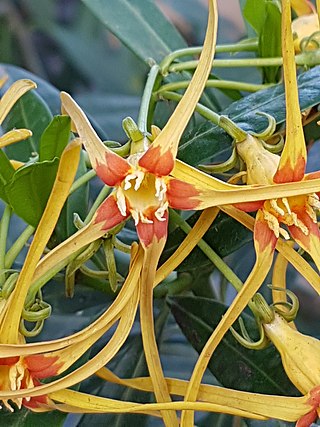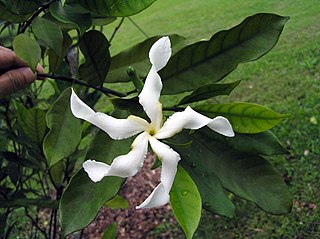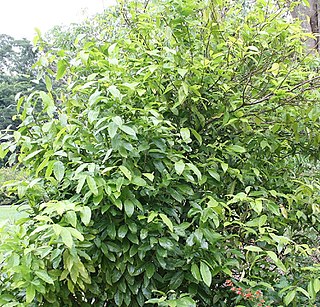
Alangium is a small genus of flowering plants. The genus is included either in a broad view of the dogwood family Cornaceae, or as the sole member of its own family Alangiaceae. Alangium has about 40 species, but some of the species boundaries are not entirely clear. The type species for Alangium is Alangium decapetalum, which is now treated as a subspecies of Alangium salviifolium. All of the species are shrubs or small trees, except the liana Alangium kwangsiense. A. chinense, A. platanifolium, and A. salviifolium are known in cultivation.
Alangium circulare is a tree in the dogwood family Cornaceae. The specific epithet circulare is from the Latin meaning "circular", referring to shape of the leaves.
Alangium havilandii is a tree in the dogwood family Cornaceae. It is named for the British surgeon and naturalist George Darby Haviland.
Alangium longiflorum is a tree in the dogwood family Cornaceae. The specific epithet longiflorum is from the Latin meaning "long flowers".
Alangium nobile is a tree in the dogwood family Cornaceae. The specific epithet nobile is from the Latin meaning "noble" or "distinguished", likely referring to the growth habit.
Maranthes corymbosa is a tree in the family Chrysobalanaceae. The specific epithet corymbosa is from the Greek meaning "cluster", referring to the clustered inflorescences.
Mastixia glauca is a tree in the family Nyssaceae. The specific epithet glauca is from the Greek meaning "bluish-grey", referring to the colour of the leaf underside.
Parinari argenteo-sericea is a tree of Borneo in the family Chrysobalanaceae. The specific epithet argenteo-sericea is from the Latin meaning "silvery silky", referring to the pubescence of the inflorescence and flowers.

Vatica rassak is a tree in the family Dipterocarpaceae, native to Maritime Southeast Asia. The specific epithet rassak is from resak, the species' Malay common name.

Strophanthus speciosus, commonly known as the forest poison rope, is a tree, shrub or woody climber which is native to southern Africa.

Tabernaemontana macrocarpa grows as a shrub or tree up to 30 metres (100 ft) tall, with a trunk diameter of up to 50 centimetres (20 in). The bark is yellowish brown, brown, grey-brown or grey. Its fragrant flowers feature combinations of cream, white and orange corolla lobes. The fruit is orange, with paired follicles, each up to 16 centimetres (6 in) in diameter. The specific epithet macrocarpa is from the Greek meaning "with large fruit". Its habitat is forests from sea level to 1,500 metres (5,000 ft) altitude. Tabernaemontana macrocarpa has been used as arrow poison. The species is native to Thailand and Malesia.
Gonystylus affinis is a tree in the family Thymelaeaceae.
Gonystylus velutinus is a tree in the family Thymelaeaceae.

Phaleria perrottetiana is a plant in the family Thymelaeaceae.
Chionanthus polygamus is a tree in the family Oleaceae. The specific epithet polygamus refers to the tree having both unisexual and bisexual flowers.

Diospyros kurzii is a tree in the family Ebenaceae. It grows up to 30 metres (100 ft) tall. Twigs dry to black. The fruits are ellipsoid, up to 1.2 cm (0.5 in) long. The tree is named for the German botanist and curator W. S. Kurz. Habitat is lowland forests. D. kurzii is found in the Andaman and Nicobar Islands, Burma, Thailand, Peninsular Malaysia, Borneo, the Philippines and Maluku.
Alangium rotundifolium is a tree in the family Cornaceae. The specific epithet rotundifolium is from the Latin meaning "rounded leaves".
Dacryodes laxa is a tree in the family Burseraceae. The specific epithet laxa is from the Latin meaning "loose", referring to the inflorescence.
Maclurodendron porteri is a tree in the family Rutaceae.
Castanopsis javanica, the Javan chestnut-oak, is a tree in the beech family Fagaceae. The specific epithet javanica is from the Latin, meaning "of Java".






